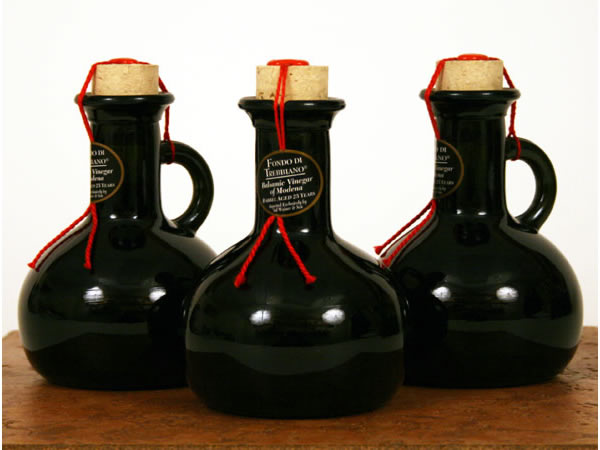Balsamic vinegar is one of those condiments that we consider a must-have in any home chef’s pantry. But not just any old bottle from the supermarket will do. It must be a true balsamic. What constitutes a true balsamic? Read on to find out.
And once you learn more and refine your taste for balsamic vinegar, you’ll likely find that you want to have several in your pantry for different uses.

What is True Balsamic Vinegar?
In the same way that true Kobe beef comes from the Kobe prefecture of Japan, as real Champagne comes from the Champagne region of France, so too genuine Balsamic vinegar comes from Modena, Italy, where it has been produced for more than 600 years.
According to Larousse Gastronomique:
“Authentic balsamic vinegar is made from selected grapes, reduced to a must and concentrated, then fermented for a year. This is the comparatively quick part of the process–the technique that makes balsamic vinegar so special is the long maturing in wooden casks for at least 10 years. The vinegar is … transferred from one cask to another, each carefully selected for the wood and the flavour it imparts. During the maturing, the vinegar evaporates during the warm summers and rests in the cool winters, to become rich, full-bodied and mellow.”
The finest balsamics are aged for at least 25 years in a succession of wooden barrels of different woods, including juniper, oak, cherry, chestnut, ash, and others. The barrels are successively smaller and smaller as the vinegar ages, due to the evaporation over time.
Along the way, as the vinegar evaporates, its flavors become more concentrated and complex.
At current price estimates, 25-year-old balsamic vinegar costs $200 or more for 3.4 fluid ounces. The rarest balsamics—aged 150 years or more—command upwards of $500 for a 3.4-fluid-ounce bottle.
Today, however, you can also buy a 16-ounce bottle of balsamic vinegar in just about any grocery store and pay less than $5. Again, according to Larousse Gastronomique, these vinegars are “not led lovingly through this process of transformation. it is particularly important to check information on inexpensive bottles to ensure that they do, at least, contain matured vinegar. Some mixtures sold as balsamic-style vinegar are no more than ordinary wine vinegar with flavouring and colouring ingredients added.”
As you can see, there’s a big difference between the real stuff and the mass-marketed variety.
Uses for Balsamic Vinegar
Of course, you can use a balsamic vinegar to drizzle over a cooked steak to add that delicious finishing touch. But there are a number of other ways that you can use balsamics in the kitchen.
Creating a Balsamic Vinaigrette
Any great salad needs a great dressing. And if you know the simple technique for making vinaigrette, you’ll have a world of flavors as your palette. Vinaigrette is one of those master recipes that every cook should and can easily master. It is endlessly variable—pair it with precision, go with your whim or whatever’s available in your pantry.
Here’s the basic balsamic vinaigrette formula:
- 3 parts oil (or 2 parts, or even 1 if you want a lighter style)
- 1 part balsamic vinegar
- Salt
- Pepper
- Fresh or dried herbs or spices (optional)
- Shallots, onions, scallions, chives, etc. (optional)
- Pinch of white or brown sugar (optional)
Experiment with any or all of the basic components—vary one or more of the basic ingredients and you’ll have a completely different flavor profile.
Glazes for Meat
Create a reduction of balsamic vinegar to use as a glaze on any meat that pairs well with fruit, such as pork and poultry.
To create the glaze, bring your balsamic to a boil, then reduce to a simmer until the volume of the vinegar is reduced by about half. The glaze is ready when it coats the back of a spoon.
You can also try this recipe for a Cranberry Balsamic Glaze that goes great with pork, poultry, or game.
Topping Desserts
A well aged balsamic vinegar boasts a thick, syrupy consistency and a flavor reminiscent of raisins, but with a tinge of acid so it’s not cloyingly sweet. This complex balance of flavors makes a well aged balsamic the perfect topping for numerous desserts.
Try it drizzled atop a premium vanilla bean ice cream, vanilla frozen custard, or fruity ice cream, such as strawberry, blueberry, or rum raisin. Even better, drizzle it over apple pie à la mode. Get creative and try it on crème brûlée, grilled strawberries, or fruit tarts.
What is your favorite use for balsamic vinegar? Have you ever had a 50-year-old or older balsamic vinegar? If you had one, what would you use it for?



Leave Your Response